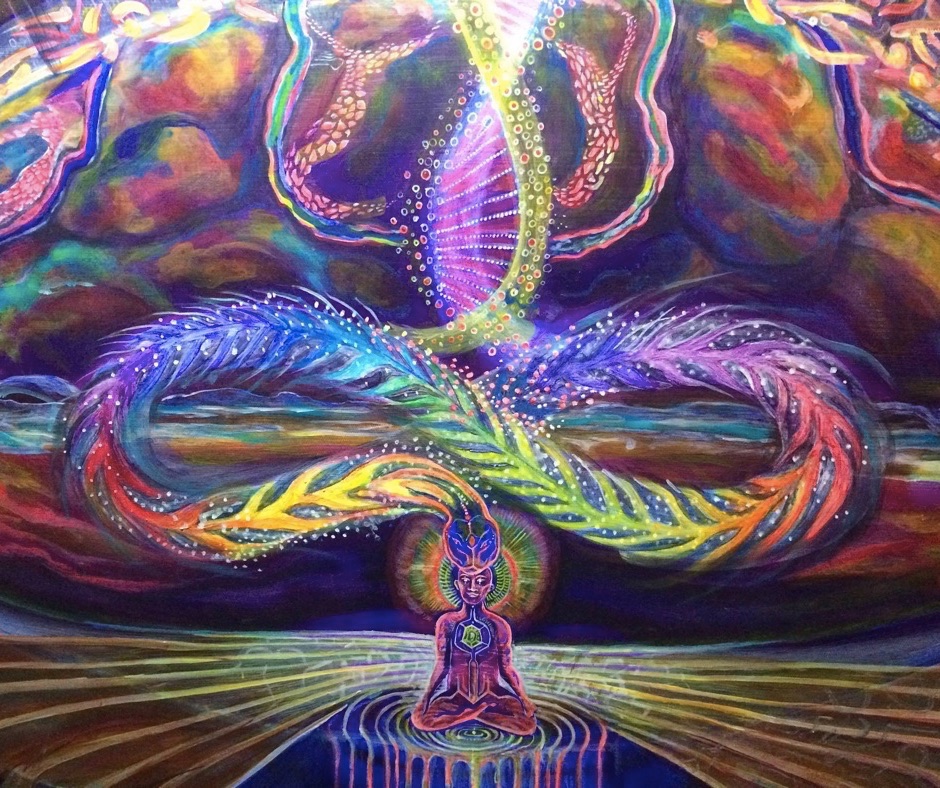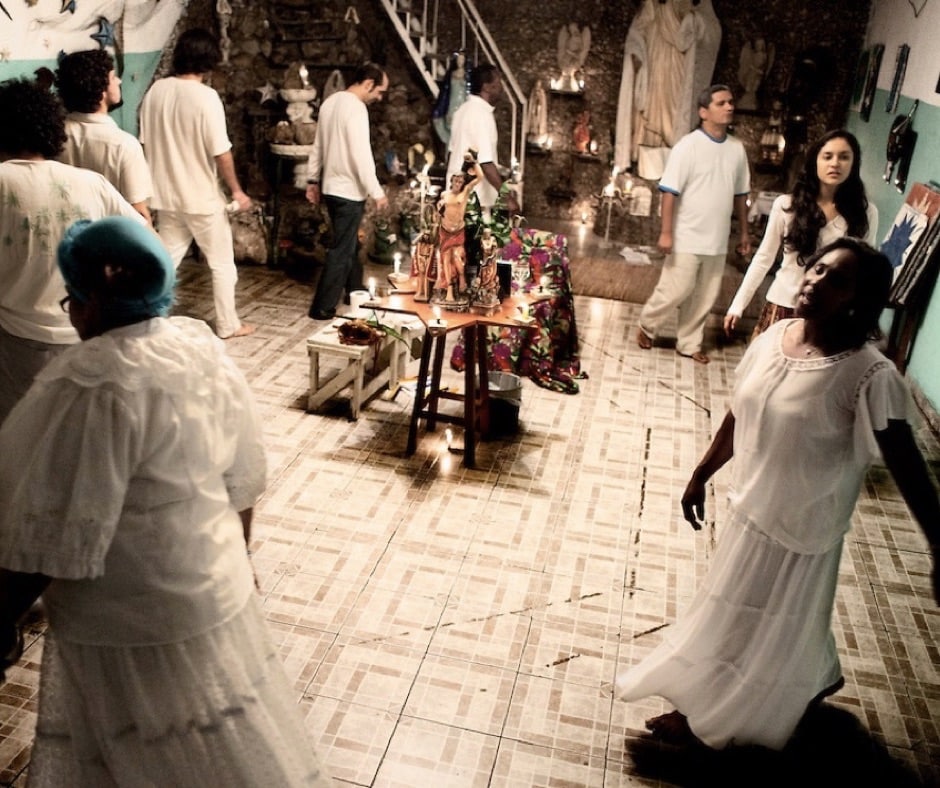Umbandaime – Ayahuasca Meets Afro-Brazilian Mediumship

The world of shamanism is full of interesting offshoots and fascinating blends of religion, culture, plant medicines, and practices. Unique amalgamations of historical lineages, psychoactive plants, and direct spiritual experience are constantly emerging from the fertile field of practice and life-way that is shamanism. Umbandaime is one of those special cultural syntheses that has resulted in a mix of spirit mediumship, the psychoactive plant medicine ayahuasca, and all with a backdrop of mystical catholicism woven into the mix. The relatively new Brazilian practice is proving to be a powerful healing force.
The History of Umbandaime
The history of Umbandaime is not an easy one to recount, as it involves the historical path of both Umbanda and Santo Daime, each rich with cultural heritage and multi-sectional lineage lines. At the risk of over-simplifying, I will attempt to boil down the essential history of how Umbandaime came to be.
In the course of the 20th Century, the traditional use of ayahuasca (a powerful hallucinogenic plant medicine originating in the Amazon) came over to Brasil and was adopted by various cultures and religions, forming new religious groups. One of the first foundational groups in Brasil that emerged as a result of blending ceremonial ayahuasca and catholicism was Santo Daime. Churches were soon founded all over Brasil, growing and expanding rapidly to other parts of the world as well. Santo Daime is now an established religion, with churches legally practicing their religious ceremonies with ayahuasca worldwide, including in the U.S.
Umbanda emerged in the late 19th century as a syncretic Brazilian religion that mixes African traditions with Roman Catholicism, and the practice of working with and channeling spirits, or “Orixás”. It was founded by a man named Zélio de Moraes, who began spontaneously incorporating a spirit into his body during a seance ceremony, leading him to the development of Umbanda. The first “terreiro” (a room for the ritual practice of Umbanda) was founded by Moraes some time in the 1920s. The original form of the practice that was adopted by Zeli de Moraes and his followers rejected the animal sacrifice and black witchcraft used in other portugese spirit channeling traditions such as the Macumba traditions. They chose instead to focus on working with the benevolent healing Orixás (spirits) in their mediumship and ritual ceremonies. Since then, many other branches of Umbanda have splintered off, but a few basic tenets of the religion have remained.
The synthesis of Umbanda and Santo Daime is mostly attributed to Padrinho Sebastião, whose bold willingness to experiment and explore unique forms of mediumship ultimately led to the development of Umbandaime. He and many others found that the cosmology of Umbanda melded quite synergistically with the Diamist world and it’s practices and beliefs. Though the exact time of it’s emergence and establishment is debatable, we estimate that it began to come about roughly around the 60’s, and taking greater shape in the mid to late 70’s. It is believed by practitioners of Umbandaime that the marriage of the two is one of divine harmony. This hymn from the website of Reino do Sol center in S. Paulo, Brasil expresses this sentiment:
“Santo Daime is the sun of my life
And Ubanda is your beloved daughter
If I have Shiva sending the transformation
I also have the fire of my great Saint John”
At the Condor Eagle Festival in Brasil, Umbandaime was represented by Gê Marques, founder of Reino do Sol.
Basic Beliefs and Practices of Umbandaime
Some of the common beliefs of Umbanda are the existence of a Supreme Creator known as Olodumare. Other widely held beliefs are the existence of deities called Orixás, most of them who are usually some representation of either Catholic saints, spirits of the dead that act as counsel and guides, or other messages from and spirits from the world of the Orixas.
Santo Daime is a religion which sprung out of incorporation of the amazonian plant medicine ceremonies use of ayahuasca. Ceremonies, or trabalhos (Brazilian Portuguese for “works”) — are usually many hours long and are typically experienced sitting in silent concentration, or with the use of collective song singing and simple dance movements in a geometrical formation. Ayahuasca, referred to as Daime within the practice, which contains several psychoactive compounds, is drunk as part of the ceremony. The drinking of the brew often induces strong physical and emotional purging, which are embraced as part of the healing action of the medicine. The ritual of the work is transmitted through songs, which often have a Christian core but incorporate other influences as well.
The ritualistic practices of Umbanda, the channeling of the Orixás, and the ceremonial use of the psychoactive, purgative and healing ayahuasca are combined to create Umbandaime.
Orixás and Spirit Channeling
In the world of Umbanda there are 12 main Orixas and a whole world of spirits which exist within 3 levels. Some of the Orixas include Oxalá (Syncretized as Jesus), and Xangô (Syncretized mainly as John the Baptist). Followers of Umbanda believe there are three distinct levels of spirits: pure spirits, good spirits, and bad spirits. Followers of Umbanda work most specifically with the pure spirits (spiritually perfected angels, cherubim, etc) and good spirits (helpful guides – usually deceased.) The bad spirits can sometimes occupy the bodies of medium and channelers, which are then left for the priests and priestesses to cleanse or send to their appropriate realm for healing.
An American man named Tom Quinn traveled to Portugal to experience the rituals of Umbanda. In his article in the Newstatesman, he writes about his guide Pai Pedro who reflected on the work by saying, “Umbanda is all about helping people,” Pai Pedro explained. “We turn to spirits to find solutions to our problems. The nature of the problem determines which spirit we invoke.” The lineage of Umbandaime is a product of the syncretism between the practice of Santo Daime and the practice of Umbanda.
The rich world of shamanism has been positively influenced and impacted by those willing to incorporate and infuse their practices in a way that continues to evolve the healing and transformational work. Umbandaime is one such evolution of shamanism that brilliantly combines the ritualistic traditions of Umbanda, the plant-wisdom of ayahuasca, and the profound gnostic and Catholic teaching of Christ.

